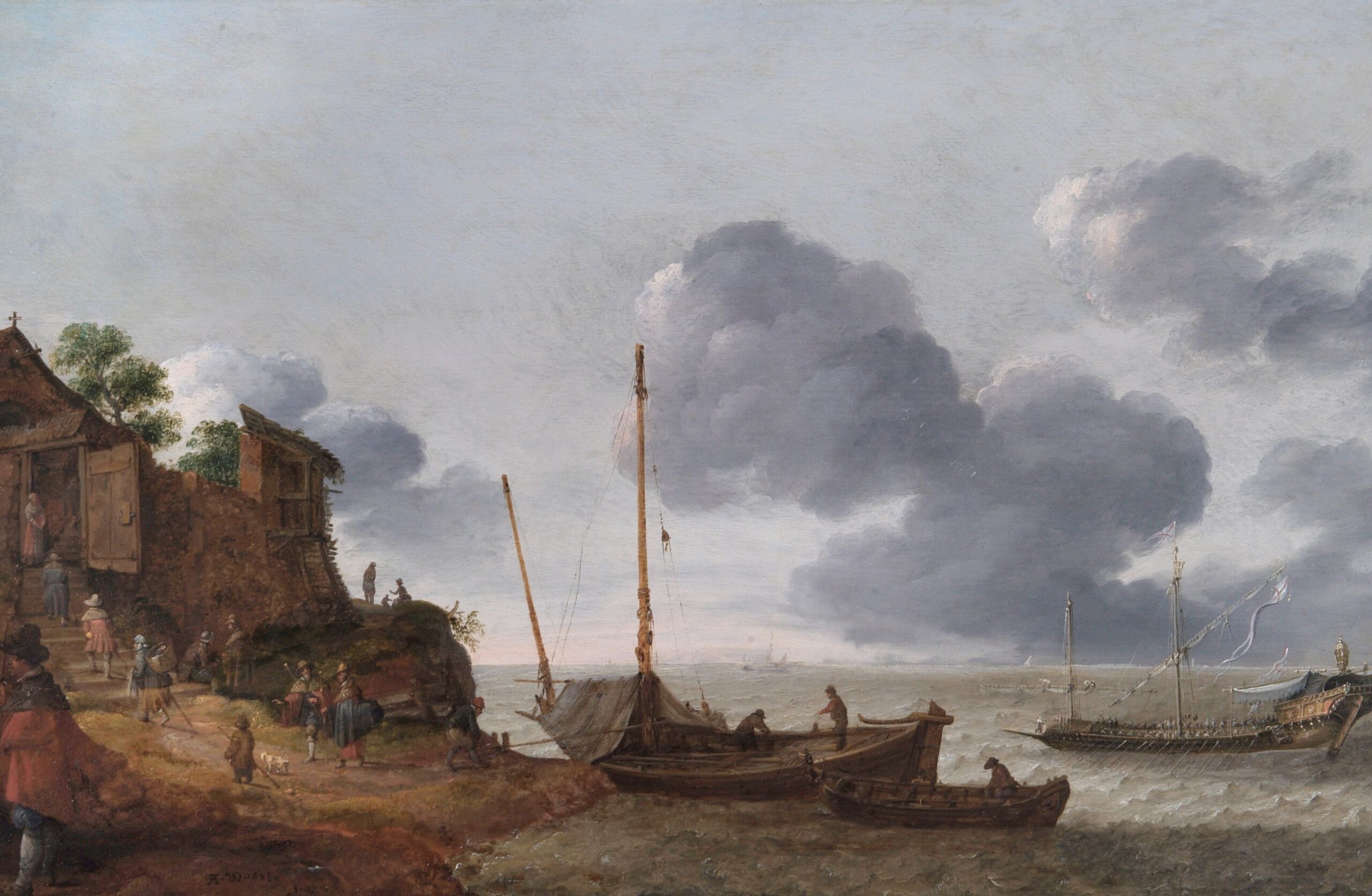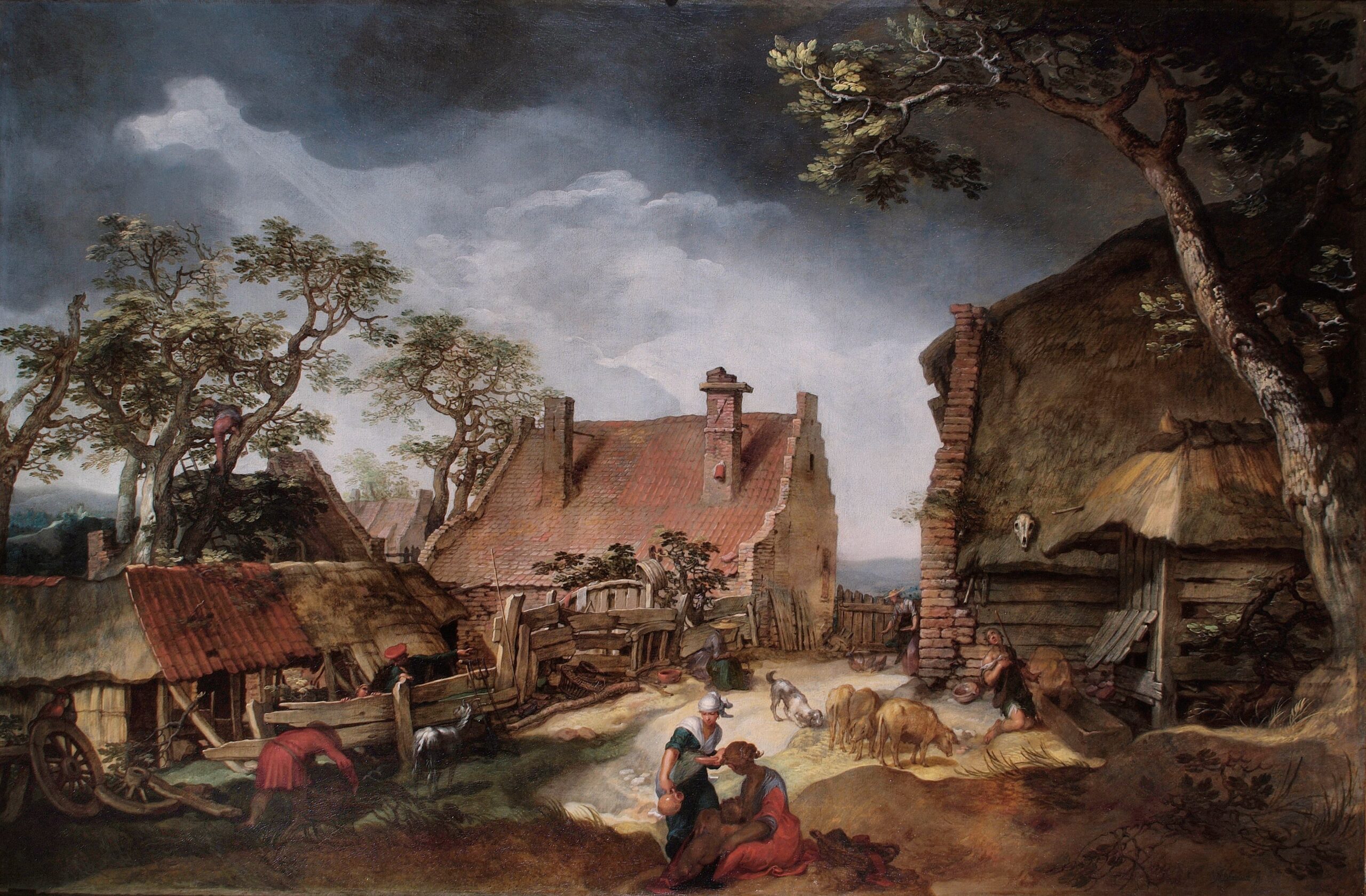A woman in a wide-brimmed straw hat scatters feed for her chickens; another breastfeeds her child. Up in the trees, a man is cutting branches with a small axe whilst others work together beneath him to mend a broken fence. The daily chores are carried out quietly and peacefully on a farm, sometime in the early years of the seventeenth century.
Abraham Bloemaert appears to offer the viewer a simple view of everyday rural life in his native Utrecht. But follow the gesture of the man in the red hat, distracted from his task, and you see a desperate soul in rags, hand clutched to his chest, kneeling amongst swine. This figure, somewhat hidden away in the right-hand side of the painting, is the eponymous character in Bloemaert’s The Prodigal Son, 1615, (Fig. 1), the star of Leamington Spa Art Gallery &Museum’s (LSAG&M) collection of Dutch paintings.
LSAG&M is situated in the heart of the Midlands in the UK. Its collection spans fine and decorative art, social history, numismatics, and ethnography. LSAG&M’s collection of Dutch paintings (44 oil paintings and one watercolor) features some of the oldest paintings in the fine art collection but was assembled fairly recently between 1950 and 2015. Their presence is somewhat unusual considering that LSAG&M’s holdings predominantly consist of nineteenth and twentieth-century British artworks. The first two Dutch paintings that were acquired for LSAG&M, in 1950 and 1953 respectively, were The Prodigal Son and Godfried Schalcken’s Self-Portrait by Candlelight, 1695, (Fig. 2) masterpieces that had previously been part of the renowned collection of the Cook family of Doughty House, Richmond. These purchases attracted two further bequests, one in 1953 from Captain Mark Field and the other in 2015 from scholar George Watson, through the Art Fund. LSAG&M’s Dutch holdings are therefore, in many ways, a collection of collections, representative not only of what was being made in the Netherlands during the seventeenth century but also of the tastes and purchasing power of three British men.

Fig. 2. Godfried Schalcken (1643-1706), Self-Portrait by Candlelight, 1695
Leamington Spa Art Gallery & Museum
It is not surprising that the largest and most renowned paintings in LSAG&M’s Dutch collection came from the collection of Sir Francis Cook (1907-1978), the great-grandson of the wealthy businessman and famous collector, with whom he shared his name, Sir Francis Cook (1817-1901). Amassed in the nineteenth century, these works formed part of an enormous collection of Italian, Spanish, Dutch, Flemish, British, and French paintings which was eventually assembled in a purpose-built art gallery that ran along the back of Doughty House in Richmond. After bomb damage prevented the collection from being displayed in its original location, a number of works travelled to LSAG&M on loan and, as part of the dispersal of the collection in the 1940s and 1950s, LSAG&M acquired two of these works permanently.
In 1953, the Gallery Committee acquired further Dutch paintings as part of the bequest of Captain Mark Field. The selection that was chosen offers an interesting insight into contemporary understandings of LSAG&M’s purpose in the middle of the twentieth century. The catalogue to the memorial exhibition showcasing the Field bequest makes no bones about the quality of the works recently acquired at the Gallery: “It is not to be pretended that there are any great masterpieces, likely to be worth thousands of pounds. There are, however, a number of paintings, by minor artists of the Dutch School, which are charming and clever examples of the skill of its painters.” The attributions of many of these works have changed over the years and Field’s bequest contains a number of later eighteenth and nineteenth-century copies based upon seventeenth-century works. This was anticipated at the time the bequest was accepted: “It would be pleasant to state without a doubt that a work is by a named artist of great fame. But does that matter so much, except to American dollars and to scholars and specialists, the latter important people, but NOT regular visitors to this little Gallery? If a painting has quality, interest, charm, skills, then it has value to the viewer, no matter who painted it.”
The exact reasoning behind the purchase of the paintings by Bloemaert and Schalcken is not clear, but one might assume that it was this same reason, with an emphasis on pleasing visitors to the Gallery more than a painting’s art historical importance, which swayed the Gallery’s Committee. Indeed, the decision to purchase the Bloemaert was surprising to the Executive Committee of the National Art Collections Fund “due to the change in tastes, for 20 years ago the name of Bloemaert was relatively unknown, and his work was not spoken of with enthusiasm”. Bloemaert is far from a household name today, with only a handful of paintings by him in British collections, but the farmyard subject of The Prodigal Son continues to attract visitors of all ages to LSAG&M, particularly children who connect with the rural setting. Neither the Bloemaert nor the Schalcken were particularly fashionable, but they were of recognizably high quality and, at the time they were purchased by LSAG&M, relatively cheap. This historic lack of interest in the Dutch collection as representative of a specific period of art history perhaps accounts for the length of time that elapsed between acquisitions. The collection was not fully catalogued and researched as a whole until 2003 by Dr Sophie Oosterwijk, and it was not until 2015 that more Dutch works were acquired for the collection, through the George Watson bequest.

Fig. 3. Adam Willaerts (1577-1664), The Landing of the Pilgrims, 1623 or 1628
Leamington Spa Art Gallery & Museum
George Watson was a scholar at Cambridge University, lecturing in English. The wealth of correspondence that exists about his collection demonstrates his strong interest in researching his paintings by communicating with scholars, dealers and curators to ascertain attributions. His collection contained works by important Dutch artists of the seventeenth century, including David Teniers the Younger, Jan Asselijn and Pieter Molijn but Watson also collected works by minor or lesser-known artists, such as Ludick van Lodewijck or studio works with uncertain attributions to Willem Drost, Nicolaes Moeyaert and Leonard Bramer. As well as personal taste, such purchases can be explained by the nature of Watson’s income, lacking the resources of a businessman like Cook. Interestingly, both the Cook and Field collection contain works which were not particularly fashionable in the mid-twentieth century, perhaps due to these budgetary constraints, but for which there is now far greater interest.
One such work is Adam Willaerts’ The Landing of the Pilgrims, painted in 1623 or 1628, (Fig. 3). This type of Mediterranean fantasy scene was common in Willaerts’ paintings. However, whilst his earlier works display a more brightly colored Flemish palette, The Landing of the Pilgrims is representative of a shift in Willaerts’ oeuvre towards a more realistic, greyer, tonal style in keeping with developments within landscape painting pioneered by Esaias van de Velde and Salomon van Ruysdael. Another interesting early work of this style within the collection is Pieter Molijns’ Landscape with Hawkers, which is thought to be one of the artists’ earliest signed paintings.

Fig. 4. David Teniers the Younger (1610-1690), The Temptation of St. Anthony, ca. 1640-1660
Leamington Spa Art Gallery & Museum
The collection can be divided according to particular themes, notably landscape, religion and portraiture, with certain works straddling multiple genres. Bloemaert’s The Prodigal Son is a superb example of the artist’s development of the ‘farmscape’, a picturesque composition inspired by the artist’s sketches made of his native Utrecht and occupies an interesting intersection between Utrecht Caravaggism and the development of more ‘realistic’ landscapes. Another religious landscape of note is David Tenier’s depiction of The Temptation of St Anthony (Fig. 4). A subject which the artists returned to on many occasions, it includes repeated symbols such as the horned woman or madam and a comically rotund bat. The composition is interesting, however, compared to other depictions of the subject with a far greater proportion of the painting depicting an external landscape compared to the devilish happenings within the hermit’s cave.
Godfried Schalcken’s Self-Portrait by Candlelight (Fig. 2) is testament to the long-standing relationship between Britain and the Netherlands. The painting was made in London in 1695 during the artist’s stay at the court of William and Mary. Schalcken travelled to Britain in a failed attempt to win the monarch’s favor and secure a role as a court painter. The work encapsulates the artist’s masterful control of light, both to generate an intimate atmosphere and to soften his features – amusingly Schalcken depicts himself a good deal younger than his 52 years.
LSAG&M’s collection, like most, contains a number of later eighteenth and nineteenth century copies. Whilst some of these works may lack finesse, they illuminate how workshops, followers and later copyists used and adapted the style and imagery of seventeenth-century masters and testify to the continuing desire for these works among collectors with a range of budgets. They also encourage us to re-examine our modern preference for ‘originals’ by the hand of the master and offer a different perspective from which to consider how Dutch art was understood during the seventeenth century and beyond. Caspar Netscher’s The Doctor’s Visit (Fig. 5) is one of at least 21 copies made after the original which was destroyed in Dresden in the Second World War.
-
Fig. 5. After Caspar Netscher, The Doctor’s Visit, ca. 1775-1800
Leamington Spa Art Gallery & Museum
-
Fig. 6. Studio of Jan de Bray, Children with a Dove, ca. 1653
Leamington Spa Art Gallery & Museum
Between 26 May and 10 September this year, LSAG&M’s Dutch collection will be on display in almost all its entirety as part of a temporary exhibition entitled ‘Going Dutch: 17th-century paintings from the collection’. This will be the first time the majority of the works will have been displayed together and the exhibition hopes to re-introduce the public and scholars to the collection. This is the beginning of a concerted effort to further research the collection, its history, and the attribution of a number of paintings and to better digitize LSAG&M’s Dutch holdings. We look forward to sharing our collection more widely in the future.
Jane Simpkiss is Art Curator at Leamington Spa Art Gallery & Museum in Royal Leamington Spa. She has been a member of CODART since 2022.



